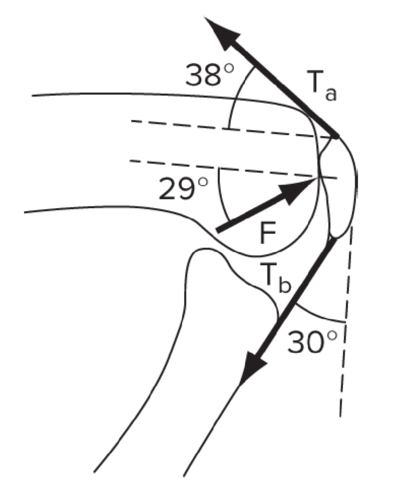
Gen Combo Ll Basic Biomechanics; Connect Ac; Maxtraq Software Ac
8th Edition
ISBN: 9781264013876
Author: Hall
Publisher: McGraw-Hill Education
expand_more
expand_more
format_list_bulleted
Concept explainers
Textbook Question
Chapter 13, Problem 10AP
Tendon forces Ta and Tb are exerted on the patella. The femur exerts force F on the patella. If the magnitude of Tb is 80 N, what are the magnitudes of Ta and F, if no motion is occurring at the joint? (Answer: Ta = 44.8 N, F = 86.1 N)

Expert Solution & Answer
Want to see the full answer?
Check out a sample textbook solution
Chapter 13 Solutions
Gen Combo Ll Basic Biomechanics; Connect Ac; Maxtraq Software Ac
Ch. 13 - Why does a force directed through an axis of...Ch. 13 - Why does the orientation of a force acting on a...Ch. 13 - A 23-kg boy sits 1.5 m from the axis of rotation...Ch. 13 - Prob. 4IPCh. 13 - Two people push on opposite sides of a swinging...Ch. 13 - Prob. 6IPCh. 13 - Prob. 7IPCh. 13 - Prob. 8IPCh. 13 - A 10-kg block sits motionless on a table in spite...Ch. 13 - Prob. 10IP
Ch. 13 - A 35-N hand and forearm are held at a 45 angle to...Ch. 13 - A hand exerts a force of 90 N on a scale at 32 cm...Ch. 13 - A patient rehabilitating a knee injury performs...Ch. 13 - A worker leans over and picks up a 90-N box at a...Ch. 13 - A man carries a 3 m, 32-N board over his shoulder....Ch. 13 - A therapist applies a lateral force of 80 N to the...Ch. 13 - Tendon forces Ta and Tb are exerted on the...
Knowledge Booster
Learn more about
Need a deep-dive on the concept behind this application? Look no further. Learn more about this topic, bioengineering and related others by exploring similar questions and additional content below.Similar questions
- A/An ____________________________ injury can be a strain or tear on any of the three muscles that straighten the hip and bend the knee. Achilles tendon hamstring myofascial shin splintarrow_forwardInflamed and swollen tendons caught in the narrow space between the bones within the shoulder joint cause the condition known as ____________________. impingement syndrome intermittent claudicationarrow_forwardIn a general sense, how do skeletal muscles produce movement?arrow_forward
- Figure 38.37 Which of the following statements about muscle contraction is true? The power stroke occurs when ATP is hydrolyzed to ADP and phosphate. The power stroke occurs when ADP and phosphate dissociate from the myosin head. The power stroke occurs when ADP and phosphate dissociate from the actin active site. The power stroke occurs when Ca2+ binds the calcium head.arrow_forwardMovement at the shoulder joint that moves the upper limb laterally away from the body is called ________. elevation eversion abduction lateral rotationarrow_forwardWhich motion moves the bottom of the foot away from the midline of the body? elevation dorsiflexion eversion plantai flexionarrow_forward
arrow_back_ios
arrow_forward_ios
Recommended textbooks for you
 Human Physiology: From Cells to Systems (MindTap ...BiologyISBN:9781285866932Author:Lauralee SherwoodPublisher:Cengage LearningLifetime Physical Fitness & WellnessHealth & NutritionISBN:9781337677509Author:HOEGERPublisher:Cengage
Human Physiology: From Cells to Systems (MindTap ...BiologyISBN:9781285866932Author:Lauralee SherwoodPublisher:Cengage LearningLifetime Physical Fitness & WellnessHealth & NutritionISBN:9781337677509Author:HOEGERPublisher:Cengage Biology: The Dynamic Science (MindTap Course List)BiologyISBN:9781305389892Author:Peter J. Russell, Paul E. Hertz, Beverly McMillanPublisher:Cengage Learning
Biology: The Dynamic Science (MindTap Course List)BiologyISBN:9781305389892Author:Peter J. Russell, Paul E. Hertz, Beverly McMillanPublisher:Cengage Learning Medical Terminology for Health Professions, Spira...Health & NutritionISBN:9781305634350Author:Ann Ehrlich, Carol L. Schroeder, Laura Ehrlich, Katrina A. SchroederPublisher:Cengage Learning
Medical Terminology for Health Professions, Spira...Health & NutritionISBN:9781305634350Author:Ann Ehrlich, Carol L. Schroeder, Laura Ehrlich, Katrina A. SchroederPublisher:Cengage Learning

Human Physiology: From Cells to Systems (MindTap ...
Biology
ISBN:9781285866932
Author:Lauralee Sherwood
Publisher:Cengage Learning

Lifetime Physical Fitness & Wellness
Health & Nutrition
ISBN:9781337677509
Author:HOEGER
Publisher:Cengage

Biology: The Dynamic Science (MindTap Course List)
Biology
ISBN:9781305389892
Author:Peter J. Russell, Paul E. Hertz, Beverly McMillan
Publisher:Cengage Learning

Medical Terminology for Health Professions, Spira...
Health & Nutrition
ISBN:9781305634350
Author:Ann Ehrlich, Carol L. Schroeder, Laura Ehrlich, Katrina A. Schroeder
Publisher:Cengage Learning


GCSE PE - ANTAGONISTIC MUSCLE ACTION - Anatomy and Physiology (Skeletal and Muscular System - 1.5); Author: igpe_complete;https://www.youtube.com/watch?v=6hm_9jQRoO4;License: Standard Youtube License